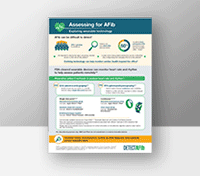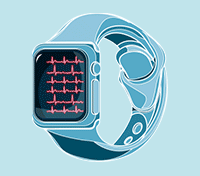
This site is intended for U.S. Healthcare Professionals.
Brought to you by Bristol Myers Squibb and Pfizer
Visit Patient Site
Explore resources to learn more about AFib
Explore technologies that can help detect potential AFib
Help your patients recognize
signs and symptoms of potential AFib
Patients with AFib are ~5X more likely to have a stroke.1
This increased risk of stroke highlights the need for accurate and timely detection. A pulse check for at-risk patients, as part of a comprehensive patient assessment during an in-office or telehealth visit, can be a critical first step in the evaluation of AFib.2,3
Patients with AFib are ~5X
more likely to have a stroke.1
This increased risk of stroke highlights the need for accurate and timely detection. A pulse check for at-risk patients, as part of a comprehensive patient assessment during an in-office or telehealth visit, can be a critical first step toward diagnosing and managing AFib.2,3
AFib may be difficult to detect in some patients, such as those with asymptomatic or paroxysmal AFib. In addition to assessing patients in-office via electrocardiogram (ECG), remote monitoring with appropriate
References:
- Wolf PA, Abbott RD, Kannel WB. Atrial fibrillation as an independent risk factor for stroke: the Framingham Study. Stroke. 1991;22(8):983-988. doi:10.1161/01.str.22.8.983
- January CT, Wann LS, Alpert JS, et al. 2014 AHA/ACC/HRS guideline for the management of patients with atrial fibrillation: a report of the American College of Cardiology/American Heart Association Task Force on Practice Guidelines and the Heart Rhythm Society. J Am Coll Cardiol. 2014;64(21):e1-e76.
doi:10.1016/j.jacc.2014.03.022 - Benziger CP, Huffman MD, Sweis RN, Stone NJ. The telehealth ten: a guide for a patient-assisted virtual physical examination. Am J Med. 2021;134(1):48-51.
doi:10.1016/j.amjmed.2020.06.015 - Ding EY, Marcus GM, McManus DD. Emerging technologies for identifying atrial fibrillation. Circ Res. 2020;127:128-142. doi:10.1161/CIRCRESAHA.119.316342











